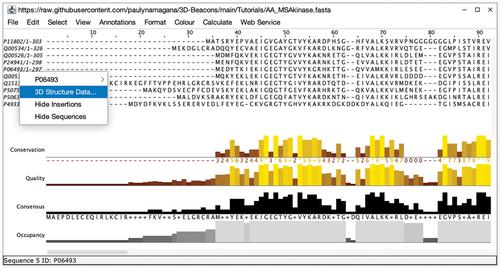{"title":"利用 3D-Beacons 网络:访问和显示蛋白质结构数据综合指南》。","authors":"Paulyna Magaña, Sreenath Nair, Mihaly Varadi, Sameer Velankar","doi":"10.1002/cpz1.1047","DOIUrl":null,"url":null,"abstract":"<p>Recent advancements in protein structure determination and especially in protein structure prediction techniques have led to the availability of vast amounts of macromolecular structures. However, the accessibility and integration of these structures into scientific workflows are hindered by the lack of standardization among publicly available data resources. To address this issue, we introduced the 3D-Beacons Network, a unified platform that aims to establish a standardized framework for accessing and displaying protein structure data. In this article, we highlight the importance of standardized approaches for accessing protein structure data and showcase the capabilities of 3D-Beacons. We describe four protocols for finding and accessing macromolecular structures from various specialist data resources via 3D-Beacons. First, we describe three scenarios for programmatically accessing and retrieving data using the 3D-Beacons API. Next, we show how to perform sequence-based searches to find structures from model providers. Then, we demonstrate how to search for structures and fetch them directly into a workflow using JalView. Finally, we outline the process of facilitating access to data from providers interested in contributing their structures to the 3D-Beacons Network. © 2024 The Authors. Current Protocols published by Wiley Periodicals LLC.</p><p><b>Basic Protocol 1</b>: Programmatic access to the 3D-Beacons API</p><p><b>Basic Protocol 2</b>: Sequence-based search using the 3D-Beacons API</p><p><b>Basic Protocol 3</b>: Accessing macromolecules from 3D-Beacons with JalView</p><p><b>Basic Protocol 4</b>: Enhancing data accessibility through 3D-Beacons</p>","PeriodicalId":93970,"journal":{"name":"Current protocols","volume":null,"pages":null},"PeriodicalIF":0.0000,"publicationDate":"2024-05-08","publicationTypes":"Journal Article","fieldsOfStudy":null,"isOpenAccess":false,"openAccessPdf":"https://onlinelibrary.wiley.com/doi/epdf/10.1002/cpz1.1047","citationCount":"0","resultStr":"{\"title\":\"Harnessing the 3D-Beacons Network: A Comprehensive Guide to Accessing and Displaying Protein Structure Data\",\"authors\":\"Paulyna Magaña, Sreenath Nair, Mihaly Varadi, Sameer Velankar\",\"doi\":\"10.1002/cpz1.1047\",\"DOIUrl\":null,\"url\":null,\"abstract\":\"<p>Recent advancements in protein structure determination and especially in protein structure prediction techniques have led to the availability of vast amounts of macromolecular structures. However, the accessibility and integration of these structures into scientific workflows are hindered by the lack of standardization among publicly available data resources. To address this issue, we introduced the 3D-Beacons Network, a unified platform that aims to establish a standardized framework for accessing and displaying protein structure data. In this article, we highlight the importance of standardized approaches for accessing protein structure data and showcase the capabilities of 3D-Beacons. We describe four protocols for finding and accessing macromolecular structures from various specialist data resources via 3D-Beacons. First, we describe three scenarios for programmatically accessing and retrieving data using the 3D-Beacons API. Next, we show how to perform sequence-based searches to find structures from model providers. Then, we demonstrate how to search for structures and fetch them directly into a workflow using JalView. Finally, we outline the process of facilitating access to data from providers interested in contributing their structures to the 3D-Beacons Network. © 2024 The Authors. Current Protocols published by Wiley Periodicals LLC.</p><p><b>Basic Protocol 1</b>: Programmatic access to the 3D-Beacons API</p><p><b>Basic Protocol 2</b>: Sequence-based search using the 3D-Beacons API</p><p><b>Basic Protocol 3</b>: Accessing macromolecules from 3D-Beacons with JalView</p><p><b>Basic Protocol 4</b>: Enhancing data accessibility through 3D-Beacons</p>\",\"PeriodicalId\":93970,\"journal\":{\"name\":\"Current protocols\",\"volume\":null,\"pages\":null},\"PeriodicalIF\":0.0000,\"publicationDate\":\"2024-05-08\",\"publicationTypes\":\"Journal Article\",\"fieldsOfStudy\":null,\"isOpenAccess\":false,\"openAccessPdf\":\"https://onlinelibrary.wiley.com/doi/epdf/10.1002/cpz1.1047\",\"citationCount\":\"0\",\"resultStr\":null,\"platform\":\"Semanticscholar\",\"paperid\":null,\"PeriodicalName\":\"Current protocols\",\"FirstCategoryId\":\"1085\",\"ListUrlMain\":\"https://onlinelibrary.wiley.com/doi/10.1002/cpz1.1047\",\"RegionNum\":0,\"RegionCategory\":null,\"ArticlePicture\":[],\"TitleCN\":null,\"AbstractTextCN\":null,\"PMCID\":null,\"EPubDate\":\"\",\"PubModel\":\"\",\"JCR\":\"\",\"JCRName\":\"\",\"Score\":null,\"Total\":0}","platform":"Semanticscholar","paperid":null,"PeriodicalName":"Current protocols","FirstCategoryId":"1085","ListUrlMain":"https://onlinelibrary.wiley.com/doi/10.1002/cpz1.1047","RegionNum":0,"RegionCategory":null,"ArticlePicture":[],"TitleCN":null,"AbstractTextCN":null,"PMCID":null,"EPubDate":"","PubModel":"","JCR":"","JCRName":"","Score":null,"Total":0}
引用次数: 0


 求助内容:
求助内容: 应助结果提醒方式:
应助结果提醒方式:


